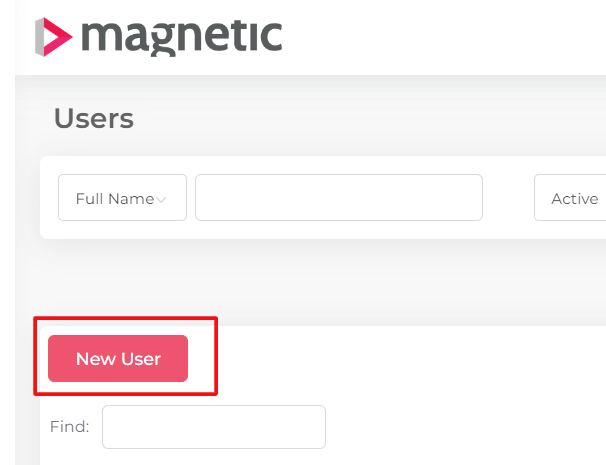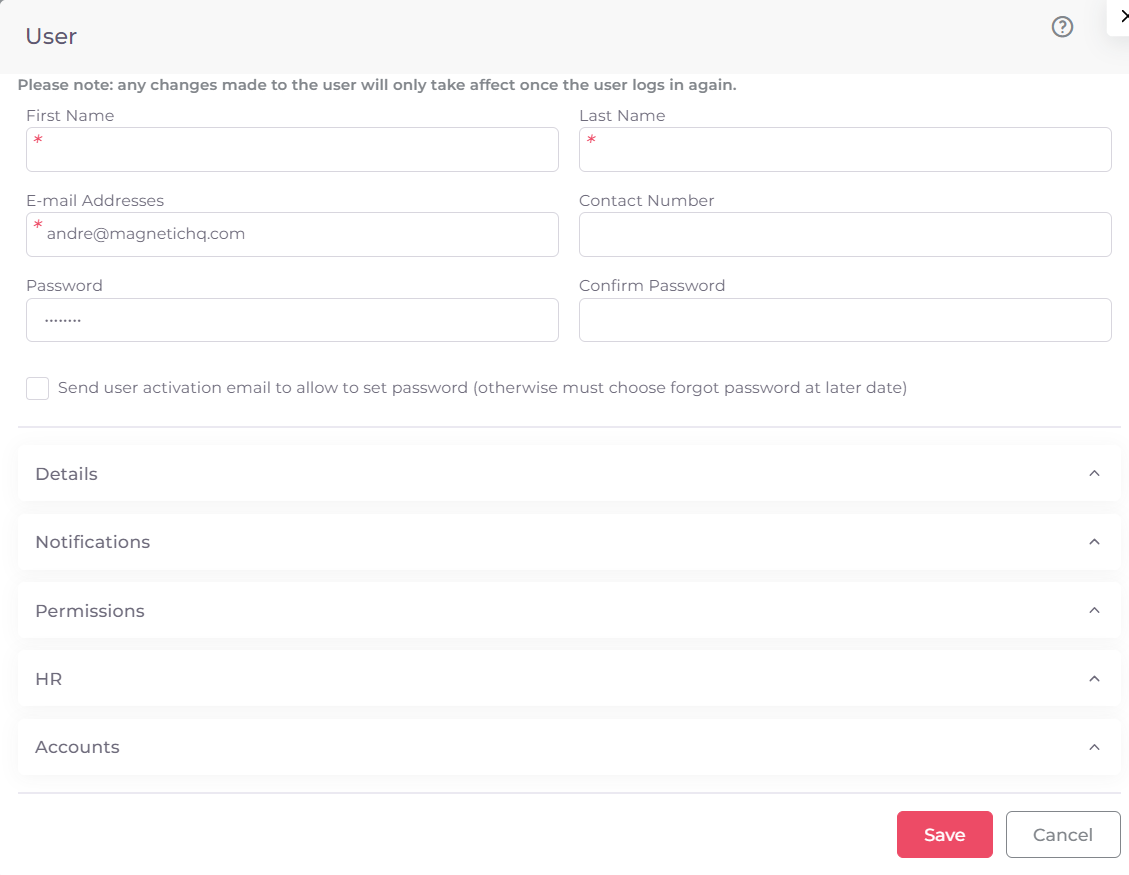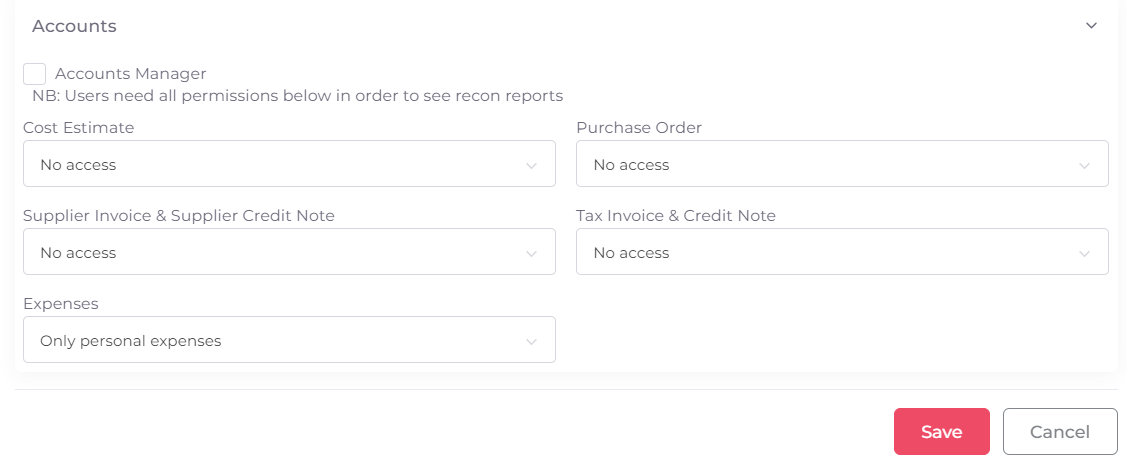1. Hover your mouse over your name in the top right corner.
2. Click on Invite & Manage Users.
3. Click on New User.
4. Fill in all sections as seen and explained below. (any that aren't applicable can be left blank)
5. It is best to select to have the user send an activation email where they can choose their own password. Therefore, leave the password out in this case.
6. We recommend you select the option to have the activation email sent to the user. This will allow the new user to choose their own password. Therefore, leave the password out in this case.
7. Hit the "Save" button once you are done
8. Once a new user is created, they can customise their own personal settings.
See the screenshots below:


Details:
- Default Billing Rate: Set the default billing rate the user is charged at when tracking billable time. The default billing rate categorises the time tracked by the user. E.g. For a designer, you may set a billing rate of a Junior at a rate of 250 per hour. This is then used to give accurate reports on time job profitability to ensure you are not over servicing clients.
- Hourly user cost: This is the estimated, internal cost of this user per hour. You could take the monthly salary of the user and divide it by 20 working days and divide it again by 6 productive hours per day to get an hourly cost. Then add 20% markup onto that hourly rate to cover general office overheads like rents and desk.
- Base capacity per day: Specify how many hours you want the user to log per day.
- Ideal capacity per day: Specify how many hours you want the user to log per day specifically on tasks/client type work
- Extra capacity per day: Specify how many extra hours you want the user to log per day
 *Note: Setting your capacities per user is recommended for accurate scheduling as well as capacity calculations on the team scheduler.
*Note: Setting your capacities per user is recommended for accurate scheduling as well as capacity calculations on the team scheduler.
- Decide what notifications they receive and how often they receive it. Users will, by default, receive a digest summary via email of all activity that affects them within 5 minutes of the activity happening. This may be too regular and an hourly summary may be preferred. It is suggested to use the in-app notifications if you want to get notifications quickly.

Permissions:
- Role: Each role has different permissions. Select the role from the dropdown menu after looking at the table below:

Overview of 5 role types:
- Admin: Has full access to ALL functions and information on the system. Nothing is hidden from these users.
- Manager: Give users this if you want them to be able to export. They own the events and users they manage. Have access to most functions and information, but no access to Company Settings.
- Premium - Users that you are able to give full access to working functions, from tasks, to finance etc. The biggest difference is that they can't perform things like adding users, deactivating users or access company settings. Majority of users in your company will be set up as premium.
- Time trackers: Basic users that just need to mostly track time on tasks/projects. Very limited access. No accounts access.
- External Collaboration: You can invite users while creating/editing a Task, Opportunity or Project by choosing to invite a collaborator as a watcher or owner. It is a free account option that gives them access to the task or job they were invited into. Any paid user in your company (this excludes users with the External Collaborator role type) are able to invite users to collaborate on a specific task or an opportunity/ project.
A specific Task User will see the opportunity / project the tasks belongs to but will not see any more info on the opportunity / project itself such as comments, files, emails, User will only see the tasks they have been explicitly given access to by way of being a task owner or task watcher.
User can make comments on the task, attach files, edit details on the task.
The user cannot track time. For this, the user needs to be made a paid user (A company admin can edit the user and change their role type from External Collaborator to Time Tracker).
An Specific Opportunity / Project
User can comment, attach files, edit the opportunity / project.
User can see linked files.
User can see all linked tasks and edit and comment on these.
User cannot see linked emails or accounts.
- Status: Make a user active or deactivated.
- Managed Users: Select the users that a Company Manager or Company Admin is in charge of. Selecting no users gives access to all users.
- Can add opportunities or projects: Give user permission to do this by ticking the tick box. If you want more control over who creates opportunities or projects, then give permissions to your Account Executives, Salesman, Traffic and Project managers.
- Set review periods.
- See all reviews and assessments.
- Set employee costs and use it in reports.
- Leave amounts entered here should be the annual amount and not the accrued to date leave amount.

- Receive HR emails: Select to receive HR emails by ticking the tick box. E.g. Managers that want to receive HR information but don't perform the HR function, will want to deselect this option so they don't get spammed with HR activity.
- Line Manager: Select this user's line manager from the dropdown menu. Line Managers receive leave requests and can edit performance reviews for users under them.
- Various types of leave: Type in how much leave they are allowed. Please enter annual amount allowed and not the accrued amount to date.
- Miscellaneous leave: e.g. study leave, bonus given, leave. The balance can be 0 and when they earn leave you can do an adjustment to give them leave.

Account Manager: Making someone the account manager gives them the following permissions:
- Can approve customers and suppliers.
- Can add/ edit item types.
- Can export accounts to external accounting systems.
Was this article helpful?
That’s Great!
Thank you for your feedback
Sorry! We couldn't be helpful
Thank you for your feedback
Feedback sent
We appreciate your effort and will try to fix the article